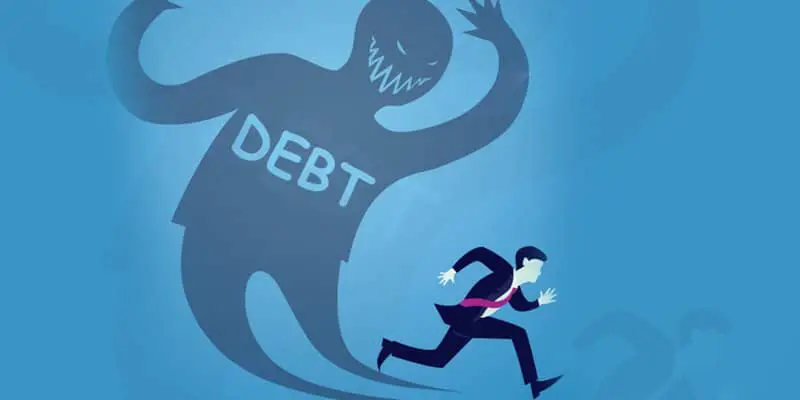Too much debt, or being overleveraged, can be a huge handicap on your finances and ability to borrow money.
When your income barely meets your expenses, you’re in trouble. If your income doesn’t even cover your debt, you have to stop right now and plan a way out of the hole you’ve dug.
Things happen, and if you’ve been accumulating consumer debt, debt from education, and buying a house you can’t afford, you’re not alone.
Consumer Debt Stats in the U.S.
For 5 years straight, Americans in total have been increasing their debt, to where it’s now a total $14 trillion in the U.S.

That’s madness, what are we even in debt for? There are things like good debt and bad debt, but debt in general is a handicap to your financial freedom.
There’s no point in comparing good debt and bad, because honestly each debt can have a pro and con based on your unique situation.
Your friend might tell you that renting is dumb, and having a house builds equity. But what if you’re married with only 1 child, and you tend to travel often for work relocation? What’s the point of owning a house then?
What about student education? Most would say this is a good debt to have, but have you noticed many who graduate with a bachelors and masters degree in something only to find a job in another career entirely?
Was the debt worth it? That’s what you should ask yourself when you’re thinking if how much debt is too much.
If it moves you forward in life, or gives you some sort of freedom that you desire, it’s worth it.
If it’s a superficial buy (like a big house that you didn’t need) or impulse buy (those $200 airpods that you also didn’t need), then it for sure wasn’t worth it.
We live in a time period where debt is part of life, leveraging the bank to get what you need is possible. It’s amazing, but not being wise about what type of debt you accrue and how you pay it off is a fool’s game.
Let’s see how people are stacking up their debt in the states.
What are the top 4 things people get in debt for?
- Housing – Currently over $9 trillion in the U.S., people love buying houses. Now in my 30s, I see all the new neighborhoods being built everywhere in my city, to supply the ever-growing demand of people who think they “deserve to have a home”. If you can pay for a house, and the mortgage payment is only 25% or less of your monthly income, go for it. Remember that you have lots of misc fees like HOA and unexpected repairs to account for.
- Student loans – A necessity for most who want to get the most out of their education. At almost $1.5 trillion, student loan debt is a mammoth. Nowadays online education can cost almost 95% less than a university education, and some employers accept such education. I’m a web designer/developer, and I know for sure that you can skip college entirely, learn online, and show an amazing portfolio to your future boss to get accepted. Some careers like doctors still need this traditional ride, but most should really consider if furthering a college education is necessary for the career they want. Is it worth the debt?
- Cars – I’ll say that housing, for the most part, is an okay debt if you can pay it off without stress, your family can grow happily in a space you can call your own. Cars are just another thing. At $1.3 trillion on total U.S. debt, auto companies make it bad when brands like BMW and Mercedes are showing ads to youth, to get one of their luxury cars in their 20s, with super-low monthly lease payments, because they “deserve it”. Ideally, you want to buy a car and not lease it, and the monthly payment should be less than 15% of your monthly income. Read more about buying vs. leasing.
- Credit cards – At $1 trillion, this is the most foolish of all U.S. consumer debt. The way I see it, credit cards should be used to conveniently pay for things, get cash back or airline points, and pay off entirely every billing period. Yes, things can happen, and you might need to add bills and pay them off in 2-3 months. Just don’t be fooled by that “minimum payment” part in your bill, you’ll be stuck in a chain for a very long time, and handsomely reward the credit card company with your hard-earned money.
Debt among the youth
I want to focus on debt for those in their 20s for a minute. If that’s not you, it’s okay. You can still learn something and share it with any friends/family who are around this period.

I’ve noticed from my research, that this is the starting period for making wise or very stupid decisions, when it comes to debt.
Your 20s is the time period when you’re done with school and starting to join the workforce. You’ll get a credit card (or several), start renting or buying, and make bigger overall purchases.
From my research, what I’ve noticed is that those who usually go down the bad road to piling up debt:
- Usually have at least 3 credit cards. At least 1 of those has a balance that isn’t being paid off.
- Have over $8k in credit card debt over those multiple cards.
- Have a poor income-to-debt ratio. When adding up cars, rent/home, and other debt payments, it accounts for over 80% of the monthly take-home income.
Another interesting thing to note from my research, is that people in California and Florida tend to have the highest percentage of debt.
Is this related to “keeping up with the joneses”, or just a coincidence? I wonder.
At such a young age, it’s extremely important in your 20s to make sure you are saving at least 10% of your income, ideally having only one credit card, and making sure that your monthly expenses are not over 50-60% of your monthly income.
So how much debt is too much for me?
Because everyones situation varies, we’re going to use a percentage method to figure out if you’re in too much debt in a specific category of debt.
We’re using your monthly income here. For this example, let’s say you’re married with no kids. You make a combined $5,500 per month.
| Type of Debt | Percentage of your income | Should be.. |
| Mortgage $1,800/mo | ~33% of total $5,550 income | 25%, you can really only afford $1,375/mo mortgage |
| Car loans $800/mo for 2 cars | ~15% of total $5,550 income | 15%, this area is okay |
| Credit cards $1,400 this month | ~25% of total $5,550 income | 25%, if it covers your food, gas, phone bill, and most other monthly expenses |
| Student loans $550/mo | ~10% of total $5,550 income | 10-15% is usually the max allowed, read more below |
- Regarding student loans, according to our federal student aid website, most student loans are capped based on your monthly income at around 10-15%. This is if you’re eligible for income-driven repayment, go see if you’re eligible here.
- Regarding credit cards, this number can vary. It could even be up to 40-50% of your monthly income, and that can be fine if your situation requires it (maybe you have 2 babies with high expenses), as long as you’re able to pay off the bill entirely that month.
How can I start getting out of debt?
It’s super important to get out of debt for two reasons. The most important one is that the less debt you have, the more money that can go towards savings and investing. The second is so you don’t get closer and closer to serious situations like foreclosure.
According to debt.org, there are over 1 million bankruptcy filings a year, and 1-in-69 homes get foreclosed on. Those are not good stats.
Let’s see what we can do to get out of debt.
1. List out all your debt
Make it simple, get out a piece of paper and list out all the debt you currently have. Here are some examples incase you might forget any:
- Mortgage
- Car loans
- Credit card balances
- Student loans
- Any other loans you made directly with a company, like buying $2,000 worth of stuff from Best Buy and then opening a card with them to pay it off in installments.
- Any medical bills that you’re paying off over time
Take that blank piece of paper, and write all the names on the left side, current balance due in the middle, and the interest rate on the right.
Keep this paper with you, review it at least once a week, so you can keep it in the front of your mind.
2. Make plans to attack the smallest one
This can be debatable, because some experts say to pay off the debt with the biggest interest rate.
You can do that too, but hear me out about why I say pay the smallest one first. Getting into debt was a psychological thing for you, and getting out of it is going to be the same.
When I made my debt worksheet a few years ago, I tackled the smallest debt first. The mental victory I got from crossing out the debt was amazing. I felt stronger.
Ever since then, I have always paid off the debt that would be erased the quickest.
3. Allocate more of your income towards debt
It might be smart to take a break from saving and investing for now so that you can take off some of that debt weight on your shoulders.
From even more research online, I was pretty shocked to see how some supposedly “wealthy” people are actually negative in their net worth.
They have million-dollar houses and fancy cars, but their savings/investments, even though maybe in the hundred thousand, are much less than all their debt obligations.
Yes that house and cars can be paid off over time, but financial freedom means having choices and protecting yourself from issues.
What if that wealthy person who is over leveraged got injured and couldn’t work? Even worse what if he/she passed away and was the breadwinner for the family?
I say it’s smart to try to remove almost all debt, aside from mortgage, and to use a bit more of your monthly income to fight towards reducing that debt.
This step is helpful a few months into your debt fighting game. If you were using 20% of your monthly income to pay off debt, and using another 10% towards saving/investing, it might be helpful to put a total 30% towards debt for a few months or every other month to tackle it heavier.
Conclusion
Getting in debt is easy, and getting out of it, while not easy, is pretty simple.
All you needed was a piece of paper with 3-columns (for the debt name, balance, and interest rate), and get to work on paying it off.
The goal is to pay off the smallest debt, have a party when you do, and get to work on the next one.
You could go harder at the debt by allocating more of your monthly income towards debt, and even work on making more by adding a side hustle or cutting costs.
I hope this post was helpful, and more importantly, shared how simple it is to start working towards getting out of debt.
Let’s work together as a whole to get ourselves out of debt, and educate our friends/family on how they can do the same.

